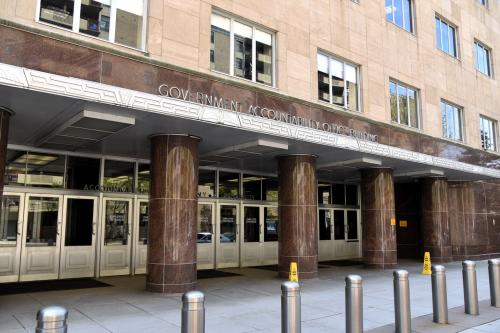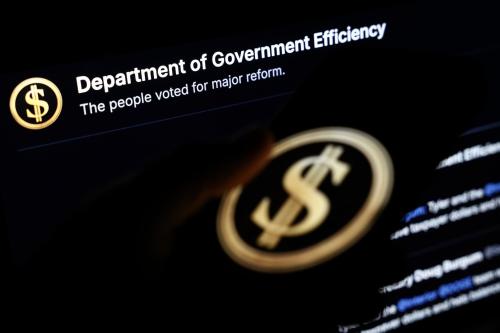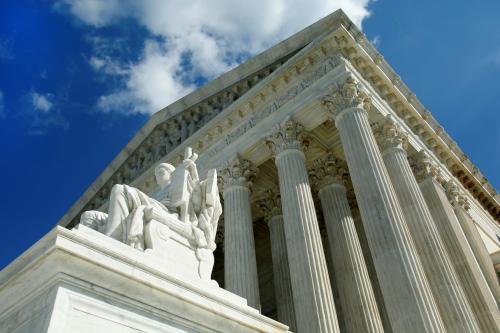President Donald Trump’s forceful exercise of presidential power has generated legal and constitutional controversies, many of which the U.S. Supreme Court will be called upon to resolve well before the president’s second term ends.
This battle over the proper extent of executive authority goes back to the country’s founding. It was the most contentious issue during the Philadelphia convention that drafted the U.S. Constitution. Disagreements about the presidency that the Constitution created flared just four years after the new government came into being, when President Washington’s proclamation of neutrality in the war between France and Great Britain sparked a famous debate between Alexander Hamilton and James Madison over the sources and limits of executive power.
During the U.S. Civil War, President Lincoln suspended the writ of habeas corpus for Confederate sympathizers. This resulted in accusations of tyrannical behavior, and in response, President Lincoln submitted his justification to Congress for its consideration. Woodrow Wilson curtailed civil liberties, including free speech and minority rights, after the United States entered World War I in April of 1917. However, after each of these wars, Congress reasserted its authority over the executive branch, and periods of relatively weak presidencies ensued.
The presidencies of Franklin Roosevelt and Harry Truman broke this historical pattern. As FDR made clear during his first inaugural address, he regarded the Great Depression as the domestic equivalent of war. He strengthened the executive branch by creating the Federal Deposit Insurance Corporation to ensure the safety of the banking system, enacting Social Security to provide a safety net for retirees, and establishing a new Executive Office of the President to provide him and his successors a larger staff, among other measures, to wage this war. Many of the institutions he established have persisted to this day, creating an enduring shift of power toward the executive in the conduct of domestic affairs. Similarly, Truman’s decision not to demobilize after 1945 (as the U.S. had after World War I) but to maintain a large standing military to oppose the Soviet Union yielded an enduring (but not unlimited) expansion of executive powers over defense and foreign policy.
Vietnam and Watergate created a crisis for the expansive executive of the New Deal and Cold War era. In 1973, a penitent Arthur Schlesinger, Jr., long an ardent supporter of the FDR/Truman legacy, penned The Imperial Presidency, a warning against a runaway executive that threatened to “override the separation of powers and burst the bonds of the Constitution.”
Schlesinger captured the moment perfectly. Within a year after his book’s publication, Congress enacted the War Powers Act and the Budget and Anti-Impoundment Act, forced President Nixon to resign, and deployed its oversight powers against institutions, such as the CIA, whose conduct had long escaped congressional scrutiny.
This newly energized legislative branch soon collided with the Reagan administration, most vividly in the conduct of foreign policy. Congress’ effort to stop the administration’s support for anti-communist military groups in Nicaragua sparked recurrent conflict between the branches. The administration’s effort to evade these restraints led to the Iran-Contra affair, and congressional hearings on this affair tied much of the administration up in knots. The administration also chafed at its diminished authority over the budget, regulations, and independent counsels.
By the end of the Reagan administration, these frustrations culminated in another pivotal volume, The Fettered Presidency: Legal Constraints on the Executive Branch, a set of essays published by the American Enterprise Institute with a foreword by Robert Bork. At the heart of this book was a critique of legislative efforts to limit—and even criminalize—the president’s exercise of necessary, indeed unavoidable, executive discretion. In the conduct of foreign policy, Bork wrote, the president’s powers “are not susceptible of definition in advance.”
Foreign policy was not the only area of disagreement. In 1989, Theodore Olsen published a wide-ranging essay, “The Impetuous Vortex: Congressional Erosion of Presidential Authority,” in which he decried the proliferation of independent agencies beyond the president’s control and argued for the then-obscure doctrine of the “unitary executive.”
The title of Olsen’s essay was a bow to a venerable concern. Writing in defense of the new constitution in Federalist 48, James Madison observed that in the state governments after the Revolutionary War, “The legislative department is everywhere extending the sphere of its activity and drawing all power into its impetuous vortex.” This tilt toward legislative power was understandable: the revolution had been mounted against a monarch whose acts, the Declaration of Independence charged, had crossed the line into tyranny. Nevertheless, Madison charged, it was a dangerous overreaction: “Legislative usurpations, … by assembling all power in the same hands, must lead to the same tyranny as is threatened by executive usurpations.”
Writing to Madison shortly before George Washington’s first inauguration, Thomas Jefferson concurred—in part: “The tyranny of the legislature is the danger most to be feared and will continue to be so for many years to come.” Then came his caveat: “The tyranny of the executive power will come in turn, but at a more distant period.”
This exchange neatly summarized the problem the Framers faced. On the one hand, their experience with the British monarchy had left them suspicious of overweening executive power. On the other hand, their experience with state legislatures left them mistrustful of legislative power as well. The most effective balance between these competing concerns was anything but obvious.
In principle, just about everyone agreed on the framework of the answer, separating powers among the branches of government so that each would check and balance the others. What this meant in practice was less clear.
Was it possible to create a presidency that was strong enough to execute the law and take the lead on foreign policy and national defense but not so strong as to be able to break through constitutional limits? How could an office that requires the exercise of discretionary judgment be confined by law? How could the executive be authorized to act forcefully in times of emergency without opening the door to autocracy? These questions did not lend themselves to easy answers in 1787, and they still don’t.
Nor is it obvious what checks and balances would mean when translated from theory into specific language. Article II, section 1 of the Constitution vested “the executive power” in the office of the president. But what is the executive power? How far does it extend? Does it create a sphere in which only the president may act?
For example, Article II, section 3 requires the president to “take care that the laws be faithfully executed.” But faithful execution requires understanding what the law means, a contested matter that the courts are often called on to adjudicate. Moreover, Congress often uses its powers of investigation and oversight to determine whether the executive branch has discharged its responsibility to execute the laws faithfully—that is, precisely and diligently.
This overlapping jurisdiction is no exception—and no accident. Madison cited Montesquieu as well as the British and state constitutions to distinguish between separation of powers and separation of functions. The U.S. Constitution separates the former, not the latter. The judiciary plays a role in legislation, as does the president. Congress and the president must reach an agreement concerning the individuals who occupy positions in the federal judiciary. And so forth.
Presidents are not allowed to enforce the laws selectively, executing the ones they like while neglecting the rest. On the other hand, executing the law takes resources that only Congress can supply. If Congress doesn’t appropriate enough to do the job, selective enforcement becomes unavoidable. But Congress and the judiciary can second-guess the priorities underlying the choices that the executive has been forced to make—for example, when President Obama cited prosecutorial discretion in using funding for immigration enforcement as a basis for establishing the Deferred Action for Childhood Arrivals (DACA) program.
Checks and balances can operate effectively to thwart the excessive concentration of power anywhere in the system only if the members of the different branches of government are motivated to defend the powers of the branch they occupy. As partisan polarization has surged in recent decades, this assumption has been called into question. Members of Congress have become less willing to challenge presidents of their party, even when the chief executive is exercising quasi-legislative functions or acting without congressional consent in matters that arguably require it.
In addition, Congress regularly hands the president and executive branch issues it should resolve legislatively but doesn’t want to because they’re politically difficult. This often involves using vague, general language to paper over disagreements in Congress, forcing the bureaucracy to take the heat for regulatory decisions that are challenged both politically and legally. This has been especially prevalent in the area of environmental policy and regulation.
Worse, Congress has handed the president more than 120 grants of emergency power, many of which give the president broad discretionary powers. President Trump is citing one of these measures—the International Economic Emergency Powers Act (IEEPA)—to justify the global and country-specific tariffs he imposed in April, even though the statutory language doesn’t mention tariffs. And he is using another open-ended power—declaring illegal immigration an invasion under the Alien Enemies Act of 1798—to justify his aggressive deportation policies.
Alexis de Tocqueville once said that “there is almost no political question in the United States that is not resolved sooner or later into a judicial question.” Because today’s polarized and supine legislative branch is unable or unwilling to discharge its core constitutional responsibilities, Tocqueville’s observation rings even truer now than when he wrote Democracy in America nearly two centuries ago.
Before the end of the Trump administration, the Supreme Court will be called on to resolve controversies over executive authority on questions ranging from imposing tariffs to firing senior officials of independent agencies. The court’s decisions will determine whether the president’s power relative to Congress will continue to expand or be limited in ways that restore the effectiveness of checks and balances.
The stakes are high. As Madison argued in Federalist 47, “the accumulation of all powers, legislative, executive, and judiciary, in the same hands… may justly be pronounced the very definition of tyranny.” If the judiciary does not halt executive aggrandizement at the expense of Congress, it will lose the power to defend itself when aggressive chief executives mount a challenge to judicial authority.
President Trump is already laying the foundation for such an attack. He has denounced judges who rule against him as left-wing activists and claims that the Supreme Court is preventing him from doing what the American people elected him to do. These arguments are intended to undermine the democratic legitimacy of the judiciary, even though federal judges are nominated by presidents elected by the people and confirmed by senators elected by the people. If a popular majority is persuaded to see the courts as illegitimate when their rulings contradict public opinion, the president could defy rulings of the Supreme Court and get away with it. And if this happens, Madison’s nightmare—the concentration of power in a single set of hands—will have become a reality.
The Brookings Institution is committed to quality, independence, and impact.
We are supported by a diverse array of funders. In line with our values and policies, each Brookings publication represents the sole views of its author(s).








Commentary
Is the growth of executive power a threat to constitutional democracy?
July 2, 2025